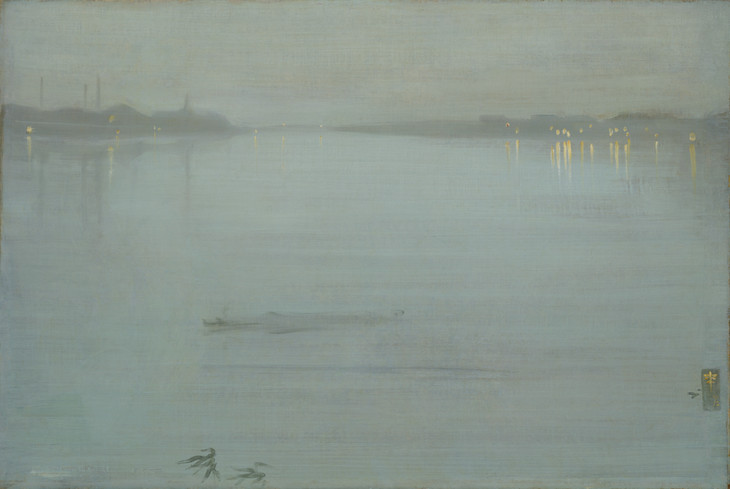The Sublime Exceeded: James Abbott McNeill Whistler’s Nocturne: Blue and Silver – Cremorne Lights
Philip Shaw
In his ‘Ten O’Clock’ lecture, delivered in 1885, Whistler mounted an attack on what he regarded as the hackneyed discourse of the sublime. He denounced art critics, in particular, for reducing the singularity of the artist’s vision to a set of predetermined codes:
a mountain, to them, is synonymous with height – a lake, with depth – the ocean, with vastness – the sun, with glory. So that a picture with a mountain, a lake, and an ocean – however poor in paint – is inevitably ‘lofty’, ‘vast’, ‘infinite’and ‘glorious’ – on paper.1
Nocturne: Blue and Silver – Cremorne Lights 1872 (Tate N03420, fig.1), with its artful deconstruction of the divisions between industry and enjoyment, truth and illusion, is similarly sceptical of the conventional, Romantic notion of the sublime. The view is of the Thames at night, looking upriver towards Battersea and Chelsea. Whistler, however, is not primarily interested in depicting reality. The blurring of the division between the mills to the left of the canvas and the lights of the pleasure gardens to the right is an artistic contrivance, a product of the artist’s commitment to the binary colour schemes of Japanese painting. The artificiality of the scene is underscored further by the use of motifs derived from Japanese woodblock printing: the painter’s butterfly signature bounded by a rectangular frame appears to the extreme right of the composition, while a bamboo-like shrub peeps above the bottom edge. The disorientating effects of the printing motifs are related to the displacement of the painting’s viewing subject. As the eye vacillates between the illusory depth of the far horizon and the two-dimensional immediacy of the butterfly icon, the viewer’s sense of spatial coherence is undermined.
A further point of disturbance is provided by the indeterminate form floating in the centre of the painting. Most likely a barge, the vague, amorphous shape nevertheless seems eerily human and, as such, is suggestive of the river’s association with violence and death. It takes time to conceive that the shape drifting towards us may be a dead body, but once this possibility is grasped we become subject once more to the uncanny force of the painting’s gaze. ‘Photo-graphed’, as the philosopher Jacques Lacan describes it, from the perspective of the no longer human, our self-fashioning as vital and heroic, perhaps even sublime, undergoes a debilitating transformation. Instead of penetrating a mystical horizon the viewer is confronted instead with an intimation of mortality that is alternately repellent and fascinating.
Paradoxically, for a work so apparently invested in the artificial and idealised, Cremorne Lights is thus radically materialist in its approach to the sublime. With its unsettling reminders of the intense pleasure of self-dissolution, Whistler’s painting challenges the traditional notion of the sublime as a staging ground for the triumphant recovery of the self from the jaws of destruction. Just as the anamorphic form in the foreground prevents the ego from encompassing the work in its totality, so those other contrivances – the decorative foliage and butterfly icon – draw attention away from the illusion of depth towards the reality of the painted surface, suggesting, in opposition to conventional Victorian narrative painting, that there is nothing beyond this painted surface.
What the painting achieves, therefore, is a sustained interrogation of its very status as a painting; neither wholly committed to flatness nor to depth, Cremorne Lights exceeds the discourse of the sublime precisely as a result of its critical engagement with all that that discourse entails: the elevation of the spiritual over the material; the disclosure of truth behind the veil of appearances; the triumph of the rational over the sensual. Still further, through its investment in the artificial rather than the ‘reality of the moment’, which modernism proudly proclaims as its mark of authenticity, Cremorne Lights announces itself as both timely and belated, as if the painting were observing itself failing to be new.
Notes
Philip Shaw is Professor of Romantic Studies in the School of English at the University of Leicester and Co-Investigator of ‘The Sublime Object: Nature, Art and Language’.
How to cite
Philip Shaw, ‘The Sublime Exceeded: James Abbott McNeill Whistler’s Nocturne: Blue and Silver – Cremorne Lights ’, in Nigel Llewellyn and Christine Riding (eds.), The Art of the Sublime, Tate Research Publication, January 2013, https://www

